Development of a solvent based recycling process for agricultural film
IF 11.2
1区 环境科学与生态学
Q1 ENGINEERING, ENVIRONMENTAL
引用次数: 0
Abstract
Agricultural films are a major source of low density polyethylene (LDPE) waste, which is challenging to recycle, as it is often multilayer and can contain pigments such as titanium dioxide (TiO2) and carbon black. In this study a dissolution recycling process was developed, that was able to recover three outputs: LDPE, poly(ethylene-vinyl acetate) and TiO2 from the waste stream with a single solvent, either xylene or limonene. After dissolution, the pigments were successfully removed through filtration. Polymer precipitation was induced by cooling and thus no antisolvent was required. The recovered polymers showed promising characteristics, with purities higher than 98 %, while the recovered TiO2 showed a purity higher than 99 %. The prospective Life Cycle Assessment (LCA) revealed a total savings of 3.35 kg CO2 equivalent per kg of film waste (for the case of black and white multilayer film) compared to incineration including energy recovery. Furthermore, a sensitivity study showed that the solvent management is crucial for the sustainability of the process.

开发基于溶剂的农用薄膜回收工艺
农用薄膜是低密度聚乙烯(LDPE)废弃物的一个主要来源,由于它通常是多层的,而且可能含有二氧化钛(TiO2)和炭黑等颜料,因此回收难度很大。这项研究开发了一种溶解回收工艺,能够回收三种产品:只需使用二甲苯或柠檬烯这一种溶剂,就能从废料流中回收低密度聚乙烯、聚(乙烯-醋酸乙烯)和二氧化钛。溶解后,通过过滤成功去除颜料。聚合物沉淀是由冷却引起的,因此不需要反溶剂。回收的聚合物显示出良好的特性,纯度高于 98%,而回收的二氧化钛纯度高于 99%。前瞻性生命周期评估(LCA)显示,与包括能源回收在内的焚烧法相比,每公斤薄膜废料(黑白多层薄膜)可节省 3.35 公斤二氧化碳当量。此外,一项敏感性研究表明,溶剂管理对于工艺的可持续性至关重要。
本文章由计算机程序翻译,如有差异,请以英文原文为准。
求助全文
约1分钟内获得全文
求助全文
来源期刊

Resources Conservation and Recycling
环境科学-工程:环境
CiteScore
22.90
自引率
6.10%
发文量
625
审稿时长
23 days
期刊介绍:
The journal Resources, Conservation & Recycling welcomes contributions from research, which consider sustainable management and conservation of resources. The journal prioritizes understanding the transformation processes crucial for transitioning toward more sustainable production and consumption systems. It highlights technological, economic, institutional, and policy aspects related to specific resource management practices such as conservation, recycling, and resource substitution, as well as broader strategies like improving resource productivity and restructuring production and consumption patterns.
Contributions may address regional, national, or international scales and can range from individual resources or technologies to entire sectors or systems. Authors are encouraged to explore scientific and methodological issues alongside practical, environmental, and economic implications. However, manuscripts focusing solely on laboratory experiments without discussing their broader implications will not be considered for publication in the journal.
 求助内容:
求助内容: 应助结果提醒方式:
应助结果提醒方式:


